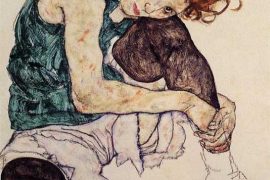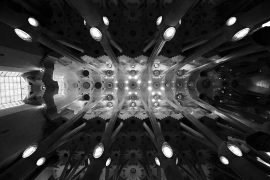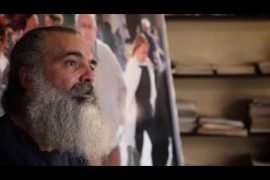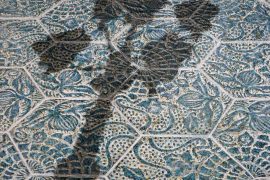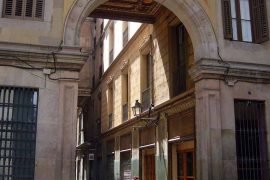[dropcap letter=”A”]
t the Grand Palais in Paris one can visit the greatest exhibition by Miró ever organised in the French capital. It is an exceptional exhibition, much complete than the great anthology that was presented in 1974 -when the painter was still alive- in the same exhibition centre.
“Ceci est la couleur de mes rêves” -“this is the colour of my dreams”- is the title of the subtle painting-poem usually at the Metropolitan of New York that also gives title to this sample of the plastic evolution of the painter through more than 150 works that are representative of his career: drawings, paintings and engravings, sculptures and ceramics.
In this great exhibition in Paris there is a piece as emblematic as La masia, from the National Gallery of Washington. In this painting one can notice the extreme precision with which the artist worked. Miró painted in detail until the smallest leave of grass. Isn’t this the same procedure employed by painters of the Gothic altarpieces? Romantic enthusiast Walt Whitman believed: “The smallest leave of grass shows that, in reality, death does not exist.”
Among other works, one can also admire, at the Grand Palais in Paris, the Autoretrat (1919) by the young Miró, Mont-roig, the church and the village, Nu debout (1918) usually at the Art Museum of St. Louis (Missouri), or Paysan catalan à la guitarre (1924) at the Thyssen of Madrid. Or the Dutch Interior (II) at the MOMA of New York. Or, coming from Philadelphia, the emblematic Le chien aboyant à la lune (1926), which should be clearly related to Goya’s Perro semihundido at the Prado Museum.
Miró’s work increases its importance with time. As a good poet, he thinks by means of images and expresses himself with images. Contemplating his works, one could say that they approach the anti-figurative pulse of music. Miró’s work soon ceases to be a literary painting, centred on an anecdote, and becomes a painting that is concentrated in the force of emotions. It ceases to be a painting more or less epic and becomes a lyrical painting.
His most characteristic plastic work is aerial, volatile: musical. Eugeni d’Or distinguished between the art of “the forms that weigh” and the art of “the forms that fly”. Miró’s works should be classified among those latter forms. It is an art, his, related to poetry and music, an art of atmospheres and silences that are projected in harmony from the depths of his humanity.
In Miró’s case, especially, but also in the case of other great artists such as Matisse, modern painting is musicalized. When Miró finds himself with himself he explores his dreams, as surrealists do. “Surrealism has allowed me to overcome clearly the artistic research: it has taken me to the heart of poetry, to the heart of joy: a joy to discover what I do, after doing it”.
At the Grand Palais one can also watch an interview with Miró, who, timid as he was, he hardly speaks, overwhelmed, he mumbles. “What do dreams represent for you?” They ask. “I never dreamed When I’m awake, I always dream”. The paradox is not a boutade and should be related to the verse “It’s when I sleep that I see it clear”, by J.V. Foix, the poet with whom Miró has so many connections.
Miró expresses himself with images, not by means of concepts. He is the author of a “visual thinking” (to use the expression of Herbert Read), a visual thought. This is the way of thinking of the primitive men and the child (the boy that Miró himself was, throughout his life). It is a thought that mainly uses the images to identify things and the analogy to advance in the knowledge of the reality. And this gives its pre-logical language a high symbolic capacity.
Betty Edwards, from the University of California in her essay Drawing on the Artist within: How to Release Your Hidden Creativity insists that there are two ways of thinking: verbal and non-verbal. Miró, obviously, thought in a non-verbal manner. Like a magician who felt connected with a harmony superior to him, he synthesized in art that persists his particular creative process. Now, the works speak on his behalf, in Paris, with the voice of his silence.



